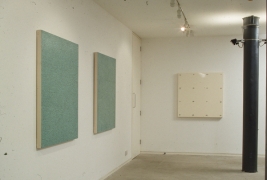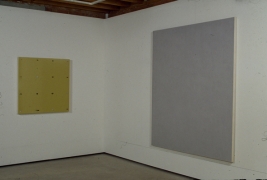FOIL
An exhibition of painting by
Edward Chell
Martin Constable
Mark Fairnington
Derrick Haughton
Kathleen Mullaniff
Eugene Palmer
Gallery Westland Place, London; Falmouth College of Arts; Herbert Read Gallery, Canterbury.
Published by FOIL. 2000. ISBN No. 0 9530661 X
Painting Out of Reticence
Michael Phillipson
“They’re holding something back aren’t they?”
“Whatever it may turn out to be you’ll find that it’s all there at the surface.”
“Yet they feel reserved, less than fully open with us, holding in on themselves, they give very little away.”
“Giving may not be art’s task. Even if their surfaces give nothing away there’s plenty on offer; maybe their challenge lies precisely in the ‘plenty’ of this ‘nothing’. Even surfaces can be restrained, reticent, without hiding anything.”
“But perhaps they are not even surfaces. Perhaps they stand aside from evenness, from the evening out of surfaces.”
“Not-yet-surfaces or more-than-surfaces you mean?”
“Well, it’s almost as if they have stopped, finished with, surfacing; as if, while being nothing but surface, surfacing no longer concerns them.”
“As if, then, they are on their way to elsewhere in a movement of re-surfacing.”
“Or turning the surface inside-out to offer us painting’s underneath, what lies behind it.”
“Which, as ever, turns out to be nothing but another surface – painting’s life sentence!”
“But more a surface in difference.”
“Although not indifferent to the now countless receding preceding surfaces of art.”
“Far from it! Neither indifferent nor nostalgic – intensively attached to the multiple of painting’s past but always across a gap they recognise as now unbridgeable.”
“So they’re taking a passionately cool look at the remains of what has passed to enable them to re-surface differently, in a somewhere-else that we not recognise.”
“They seem to propose that painting re-surface itself with remnants that have been side-lined, forgotten, thrown aside, suppressed, in an insane on-rush of the hyper-techno-speed-up which seems to be dragging us and art along in its wake.”
“That drag is unavoidable. But painting against the flow wants to recover the lost forgotten things and relations which we lose sight of at our peril.”
“Thus, withdrawing from the speed-up, painting, on its very own terms, tries to catch hold of and make absolutely still those things we and art are endlessly losing about ourselves without ever quite noticing. It wants to fuse these things into the surface, to make them and the surface finally indistinguishable. The surface is all it has got to get these things over to us.”
“It begins to sound like a task of allegorising in which, with a certain melancholy, that which is beyond the surface can only be envisioned by just this surface in all its elusive particularity. Such paintings begin to insinuate themselves as reminders of loss, then, of what has gone missing for us and art; the painjoys of re-memoration, the thinkfeels of touch, the trembletrances of place, the imageblurs of others.”
“Showing how we have become missing persons perhaps?”
“Missing to ourselves…”
“…but painting to make visible the holes, the absences, in our own becoming.”
“So, although these surfaces are just ‘there’, they offer nothing positive?”
“Well, art, painting-as-art, is neither therapeutic nor pedagogic. In its exorbitant weakness it can certainly offer us opportunities for unbecoming, for turning towards and searching out in each of its objects that which we are not, yet, or that which we were without ever quite realising it.”
“It may be weak but surely it will try to offer something specific to itself that will attract us, draw us into itself, otherwise we would pass by in indifference?”
“Yes, it needs to intrigue, seduce, us to get to the pointless point where we can start to give ourselves away, give ourselves up to it, give way to its offer.”
“That may be a slow process; it will take patience and perhaps some discomfort to demean ourselves, to allow ourselves to be drafted out of the meanings that give us our everyday securities.”
“It is just this patience which this seduction wants to engender in us. Through them we may take the opportunity, for our own good, of becoming other to the rush-past of things.”
“These paintings try to slow us down, to draw us into their other time…”
“…offering us the chance of becoming still again…”
“…a still becoming: how we can become still yet still become…”
“…painting here as the stilling of art…”
“…a slow-release fertiliser, allowing its own image-rhythm to distill outside any recognisable seasonal cycle.”
“Sounds like a chronic condition.”
“In their stillness they enable us to become acutely aware of our and art’s chronic state, its untimely becoming.”
“The far side of reserve, mute, still, withdrawing, shy even…”
‘…although some might call them brazenly up-front in their surface celebration…”
“…they need this surface attraction to draw us in, and they need us to find and then to pose on their and our behalf the intense particularity of their questions to themselves…”
“,,,.and to art…”
“…questions right there at their surfaces…”
“…as their surfaces…”
“They are all we’ve got to go on…”
“…got to go on…”
Michael Phillipson, November 2000.

